ALP 5.2%
Incumbent MP
Ron Hoenig, since 2012.
Geography
Inner south of Sydney. Heffron covers southern parts of the City of Sydney, as well as northern parts of the City of Botany Bay. Heffron also covers those parts of Marrickville Council to the east of the Illawarra railway line, and small parts of Randwick Council. Key suburbs include Redfern, Waterloo, Eveleigh, Alexandria, Zetland, Beaconsfield, Kensington, Kingsford, Rosebery, Eastlakes, Mascot, St Peters and Tempe. Heffron also covers Moore Park and Centennial Park.
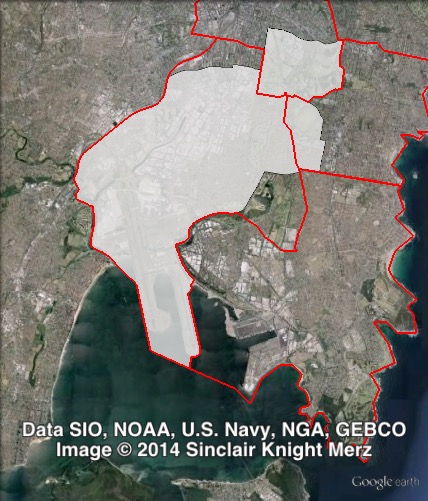
Redistribution
Heffron lost Redfern to the new seat of Newtown and Daceyville and Pagewood to Maroubra, and gained Kingsford, UNSW and Randwick Racecourse from Coogee and Moore Park and Centennial Park from Sydney. These changes cut the Labor margin from 7.1% to 5.2%.
History
The district of Heffron has existed since 1973. It has always been held by the ALP.
The seat was first won in 1973 by Laurie Brereton. He had previously held the seat of Randwick for one year. He won it in a 1970 by-election following the election of the previous member Lionel Bowen to the federal seat of Kingsford Smith in 1969. Randwick was abolished at the 1971 election.
Brereton served as a minister in the Labor state government from 1981 to 1987, and held Heffron until 1990, when he resigned to contest Kingsford Smith. He served as a minister in the Labor federal government from 1993 to 1996 and a shadow minister from 1996 to 2001. He retired from Kingsford Smith in 2004.
Brereton was replaced at the 1990 Heffron by-election by his sister Deirdre Grusovin, who had been a member of the Legislative Council since 1978. She had served as a minister from 1986 to 1988.
Grusovin held Heffron at the 1991, 1995 and 1999 elections. In 2003 she lost a bitter preselection contest against Kristina Keneally.
Keneally won a second term in Heffron in 2007. Following the 2007 election she was appointed as a minister. In 2009, the ALP caucus elected her as Labor leader, and she succeeded Nathan Rees as Premier of NSW.
Keneally led the ALP into the 2011 state election, where the party was reduced to only 20 seats, after holding over 50 prior to the election.
In June 2012, Keneally resigned from Parliament. The ensuing by-election was won by Labor candidate Ron Hoenig, the mayor of Botany Bay.
Candidates
- Anastasia Bakss (No Land Tax)
- Ron Hoenig (Labor)
- Shawn Arbeau (Christian Democratic Party)
- John Koutsoukis (Liberal)
- Osman Faruqi (Greens)
Assessment
In a Labor vs Liberal race, Labor’s hold on Heffron is safe. The biggest threat to Labor is likely to come from the Greens, but they are not in an immediate position to win the seat. The Greens need to close what was a 14-point gap at the last election, and has been made wider by the redistribution, in order to outpoll the Liberal Party. Some parts of Heffron resemble the Labor-Greens marginal seats of Balmain and Newtown, but these suburbs share a seat with suburbs that are much less Green-friendly.
While the Greens vote is very strong in suburbs like Erskineville, St Peters, Tempe and Alexandria, and is growing in the rest of the South Sydney area, other parts of Heffron look quite different. Kensington and Kingsford are very strong for the Liberal Party, and more resemble eastern suburbs seats where the Greens vote is relatively strong, but not strong enough to win a seat. Those parts of the seat in the Botany Bay council area (such as Mascot and Eastlakes) are very strong for Labor and relatively poor areas for the Greens – they more resemble the western suburbs where there is a high Labor vote, but not the type of Labor voter that is easy for the Greens to recruit.
2011 election result
| Candidate | Party | Votes | % | Swing | Redist |
| Kristina Keneally | Labor | 18,870 | 41.2 | -15.2 | 39.7 |
| Patrice Pandeleos | Liberal | 15,226 | 33.3 | +11.5 | 35.1 |
| Mehreen Faruqi | Greens | 8,681 | 19.0 | -0.7 | 17.7 |
| John Forster | Independent | 1,865 | 4.1 | +4.1 | 3.5 |
| Katalin Ferrier | Christian Democrats | 871 | 1.9 | +1.9 | 1.9 |
| Trevor Rowe | Independent | 254 | 0.6 | +0.6 | 0.5 |
| Others | 1.5 |
2011 two-party-preferred result
| Candidate | Party | Votes | % | Swing | Redist |
| Kristina Keneally | Labor | 22,299 | 57.1 | -16.6 | 55.2 |
| Patrice Pandeleos | Liberal | 16,780 | 42.9 | +16.6 | 44.8 |
2012 by-election result
| Candidate | Party | Votes | % | Swing |
| Ron Hoenig | Labor | 20,501 | 58.9 | +17.7 |
| Mehreen Faruqi | Greens | 8,122 | 23.3 | +4.4 |
| Drew Simmons | Democrats | 3,749 | 10.8 | +10.8 |
| Robyn Peebles | Christian Democrats | 2,442 | 7.0 | +5.1 |
2012 by-election two-candidate-preferred result
| Candidate | Party | Votes | % |
| Ron Hoenig | Labor | 21,863 | 70.0 |
| Mehreen Faruqi | Greens | 9,366 | 30.0 |
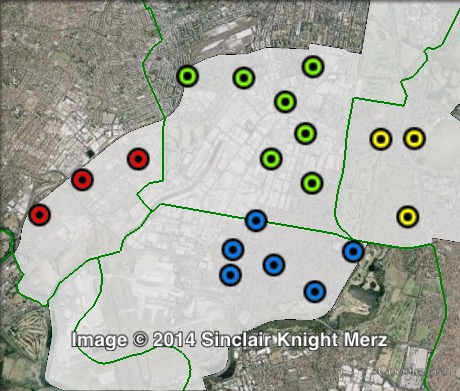
Booth breakdown
Due to changes in electoral boundaries, the electorate has been broken up slightly differently for the 2011 election results (redistributed boundaries) and the 2012 by-election results (non-redistributed boundaries).
For the redistributed boundaries, the seat has been split into four parts based on local government boundaries:
- Central – City of Sydney
- East – Randwick
- South – Botany Bay
- West – Marrickville
The ALP’s primary vote ranged from 31.3% in the east to 53.8% in the south. On a two-party-preferred basis, Labor’s vote ranged from 41.8% in the east to 69% in the west, with Labor also winning majorities in the south and centre.
The Liberal primary vote ranged from 21% in the west to 49% in the east, while the Greens vote ranged from 9% in the south to 29% in the west. The Greens outpolled the Liberal Party in the west, while the Liberal Party managed to outpoll Labor in the east.
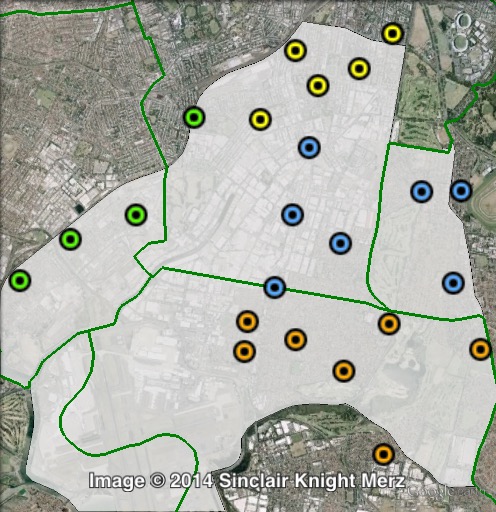
For the old boundaries (used for the by-election), the seat has been split into four areas based on key suburbs: Kensington-Rosebery, Mascot, Redfern-Waterloo, and West. The “west” in this case also includes Erskineville, as well as Tempe and St Peters.
At the 2012 by-election, Labor won a massive 86.8% of the two-candidate-preferred vote (against the Greens) in Mascot, but won less than 60% in the west and in Redfern-Waterloo.
Labor’s primary vote ranged from 46% in Redfern-Waterloo to 78.8% in Mascot. The Greens vote ranged from 36% in Redfern-Waterloo and the West to 10% in Mascot.
2011 election breakdown
| Voter group | ALP % | LIB % | GRN % | Total | % of votes |
| South | 53.8 | 30.5 | 9.1 | 9,691 | 24.1 |
| Central | 36.3 | 33.8 | 24.0 | 8,512 | 21.2 |
| East | 31.3 | 49.1 | 13.7 | 5,252 | 13.1 |
| West | 43.9 | 21.3 | 28.5 | 3,025 | 7.5 |
| Other votes | 34.2 | 37.0 | 19.1 | 13,719 | 34.1 |
2012 by-election breakdown
| Voter group | ALP % | GRN % | Total | % of votes |
| Mascot | 78.8 | 10.1 | 9,910 | 28.5 |
| Kensington-Rosebery | 53.7 | 23.4 | 8,402 | 24.1 |
| Redfern-Waterloo | 46.0 | 36.0 | 5,720 | 16.4 |
| West | 47.2 | 36.2 | 4,244 | 12.2 |
| Other votes | 54.2 | 23.8 | 6,538 | 18.8 |
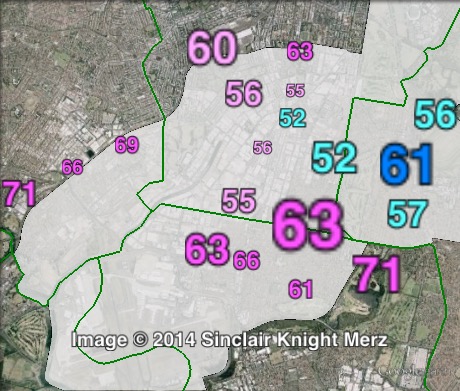
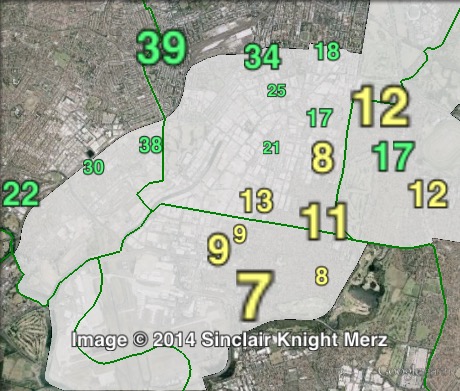
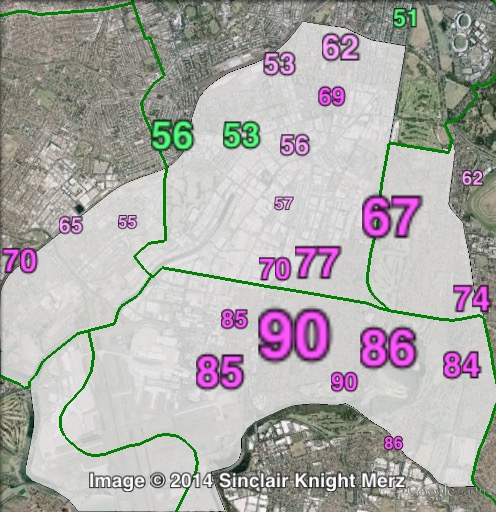


My prediction: Easy Labor hold, and the Liberals to remain in second.
Anton probably right but Ddepends on the extent of the swing against the Liberals – Greens may end up breathing down Liberals neck for the second position
The only seat named for a former premier, and a fairly middling one at that. It is perhaps the only seat named solely for a person; even Oxley and Wakehurst share their names with major roads in their district.
I have no idea why they didn’t remove the part of Marrickville council currently in this seat at the redistribution. That seemed a complete no-brainer.
Longer term, I can see this becoming a three-way marginal. Gentrification will help the Greens but also the Liberals here.
Greens were dissatisfied with their result here, both in 2011 & 2012. They could do better in the St Peters area, but I just can’t see this being anything but safe Labor for the next 20 years. Botany Bay is just so strong, particularly for Hoenig who was a popular mayor for something like 30 years.
For as long as Sydney’s major airport is situated where it as, and for as long as planes make noise, I don’t see this electorate trending Liberal.
I could see Heffron trending Green, as development in the Alexandra/Waterloo area gives it a greater inner city character.
My old electorate.
With respect to them, the Libs have chosen some pretty dud candidates here. The one this time and last seemed to be picked on the basis that they have a Greek-sounding last name – and Heffron has a lot of older Greek migrants (this one at least lives in the electorate).
Before that they preselected a Randwick Councillor named Scott Nash, who rather famously said that if he lived in the electorate he’d vote for Kristina Keneally, a quote she used quite widely.
“not the type of Labor voter that is easy for the Greens to recruit.” I think the words you’re looking for, Ben, are “working class.” As in, “the Greens cannot win working class votes.”
Thanks for telling me what I think, Adam, but that’s actually not what I meant. There are plenty of voters who are very much middle-class in places like Western Sydney (and parts of Heffron) who aren’t particularly Greens-friendly.
Video from Heffron candidates forum here: https://www.youtube.com/watch?v=KMRw6zj9m1s&index=1&list=PL6PRUprO-7R1HU8n2ElscTTgfmyyfuJcs
Whilst I voted for him as I’m staunch Labor I do have a problem with our MP having Ken Doll hair